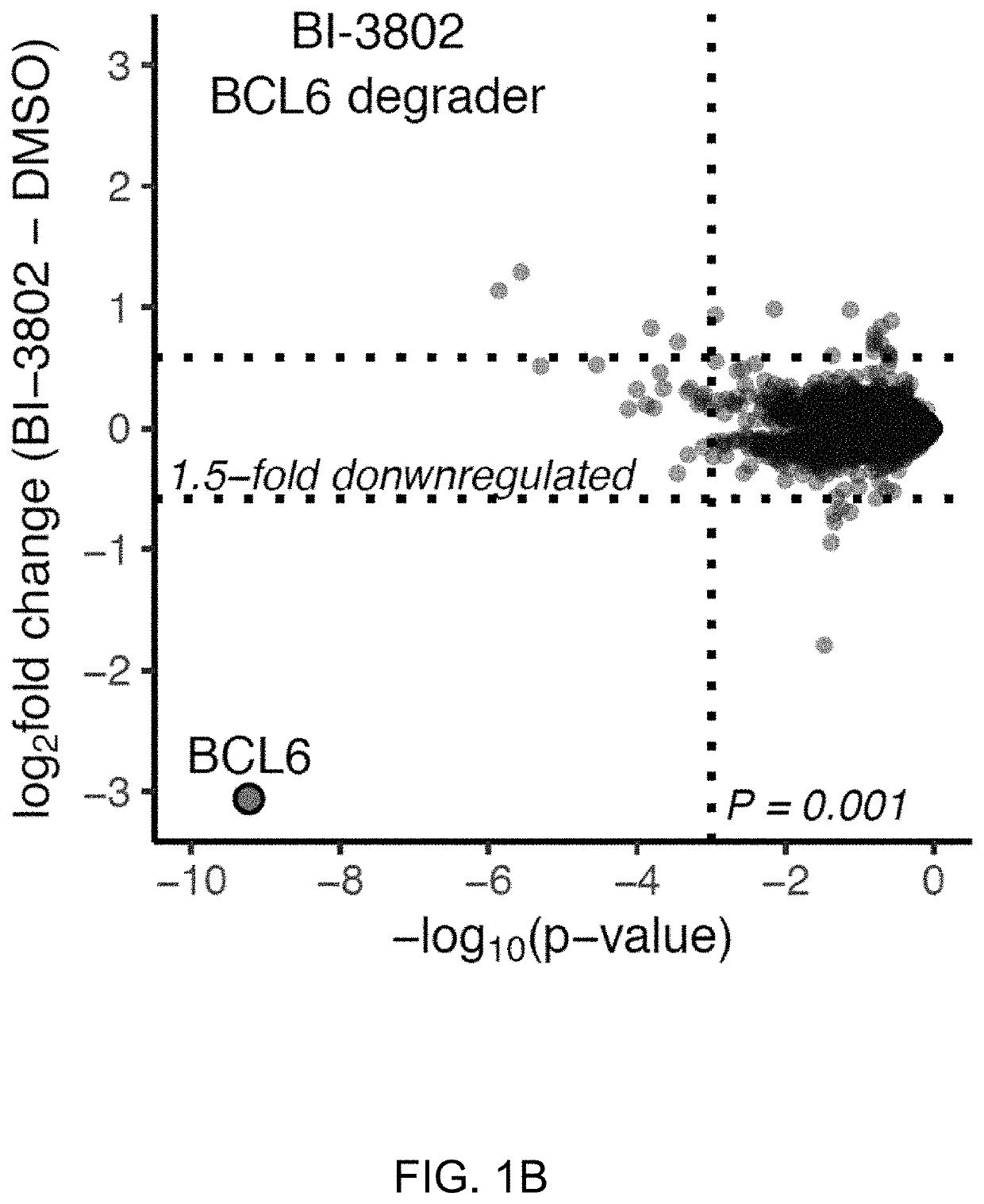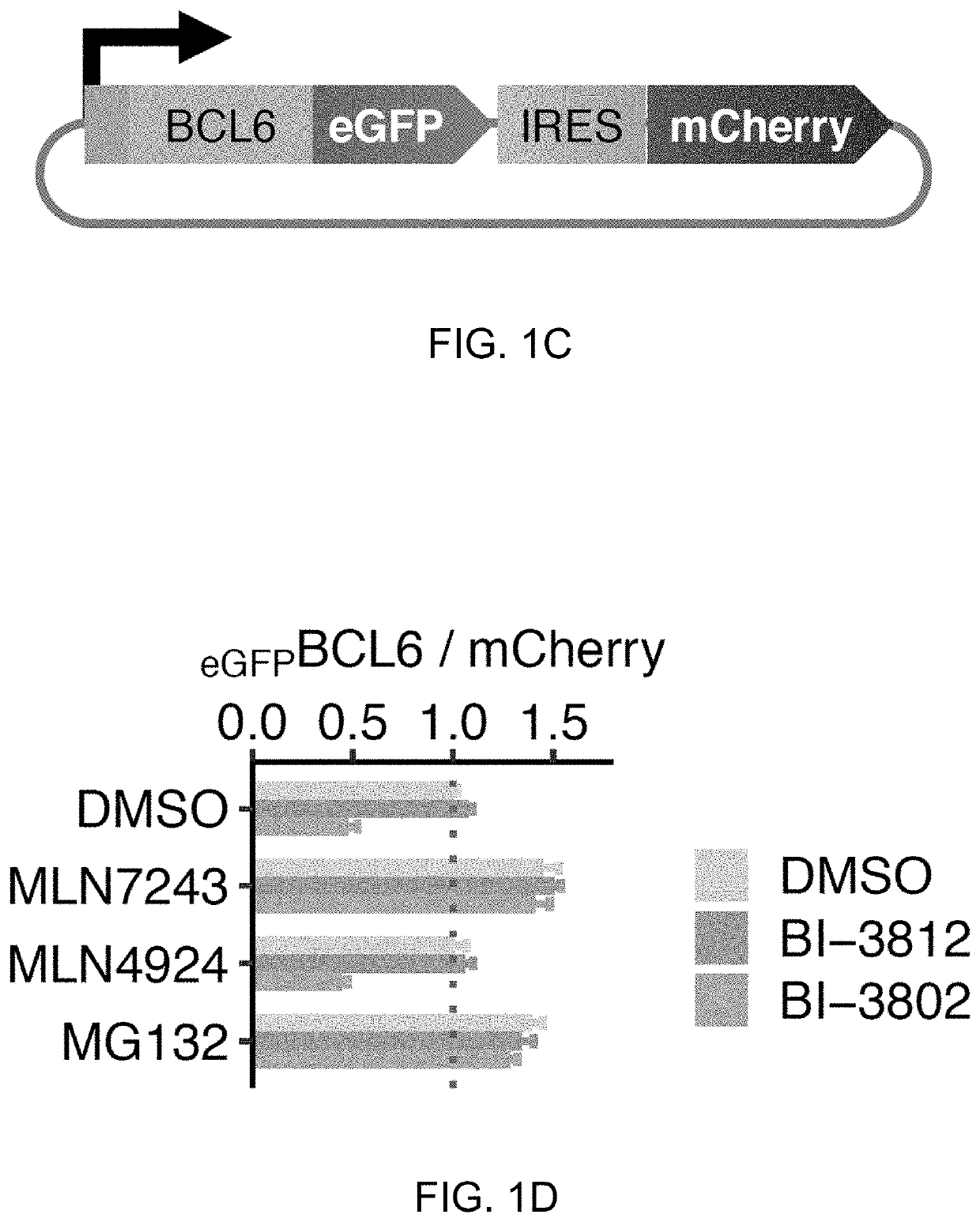Chemically inducible polypeptide polymerization
a polypeptide, chemically inducible technology, applied in the direction of peptides, peptide sources, fusion with degradation motif, etc., can solve the problems of tumor stasis, protein recalcitrant to this approach, limited translation into clinical therapeutic agents,
- Summary
- Abstract
- Description
- Claims
- Application Information
AI Technical Summary
Benefits of technology
Problems solved by technology
Method used
Image
Examples
example 1
nduces Specific BCL6 Degradation
[0173]To determine the specificity of BI-3802 as a compound inducing enhanced degradation of BCL6 (FIG. 1A), quantitative mass spectrometry (MS) based proteomics was performed in SuDHL4 cells, a DLBCL-derived cell line, following compound treatment for 4 hours. BCL6 was the only polypeptide with significantly decreased abundance (FIG. 1B). BI-3802 efficiently depleted chromatin-bound BCL6 and did not alter BCL6 mRNA expression (FIGS. 5A and 5B). Treatment with the structurally similar BCL6 inhibitor BI-3812 (FIG. 1A) did not alter the abundance of any polypeptide (FIG. 5C).
[0174]To identify the critical region of BCL6 that mediates drug-induced degradation, a fluorescent reporter system was generated in HEK293T cells, in which the full length BCL6 (BCL6FL) was fused in-frame with eGFP followed by an internal ribosome entry site (IRES) and mCherry (FIG. 1C). BI-3802 induced degradation of the full-length BCL6 reporter, while the inhibitor, BI-3812, did...
example 2
nduces Cellular BCL6 Foci
[0176]Cellular localization of the BCL6-eGFP fusion construct upon exposure to BI-3802 was examined by live cell fluorescence microscopy. Strikingly, the appearance of distinct eGFP-containing foci was observed within minutes of BI-3802 treatment for both the full length BCL6 construct and the minimal degradable construct eGFPBCL61-275 (FIG. 1F). The eGFP signal and foci subsequently disappeared, consistent with BCL6 degradation. Immunofluorescence studies in SuDHL4 cells confirmed that endogenous BCL6 also formed foci upon treatment with BI-3802 (FIG. 5F). Addition of an excess of the inhibitor BI-3812, which competes for the same site on the BCL6-BTB domain, efficiently blocked BI-3802-induced BCL6 degradation (FIG. 5G). To interrogate the dynamic of drug induced foci formation, a BTB containing, non-degradable eGFPBCL61-250 construct was utilized that similar to wild type BCL6 formed BI-3802-induced foci that, however, persisted even after prolonged drug ...
example 3
nduces BCL6 Polymerization
[0177]To explore the molecular basis of BCL6 foci formation, the behavior of recombinant BCL6 was examined in vitro. During purification of BCL6 recombinant polypeptide, presence of BI-3802, but not BI-3812, led to higher molecular weight species of BCL6 (FIG. 2A). Given the formation of reversible cellular foci upon BI-3802 treatment, a hypothesis was developed that BCL6 might form regular higher-order structures upon binding to BI-3802, which was examined by negative stain electron microscopy (EM). In the absence of BI-3802, BCL6 was present as monodisperse particles. However, upon incubation of BCL6 with BI-3802, the formation of regular structures with a sinusoidal shape was observed, increasing in length with higher concentration of BI-3802 (FIG. 2B).
[0178]To model the filaments, two BCL6-BTB domain dimers (PDB: 5MW2) were computationally docked in the presence of BI-3802 to determine energetically favorable binding modes, and the structure was extende...
PUM
| Property | Measurement | Unit |
|---|---|---|
| temperatures | aaaaa | aaaaa |
| temperatures | aaaaa | aaaaa |
| temperatures | aaaaa | aaaaa |
Abstract
Description
Claims
Application Information
 Login to View More
Login to View More - R&D
- Intellectual Property
- Life Sciences
- Materials
- Tech Scout
- Unparalleled Data Quality
- Higher Quality Content
- 60% Fewer Hallucinations
Browse by: Latest US Patents, China's latest patents, Technical Efficacy Thesaurus, Application Domain, Technology Topic, Popular Technical Reports.
© 2025 PatSnap. All rights reserved.Legal|Privacy policy|Modern Slavery Act Transparency Statement|Sitemap|About US| Contact US: help@patsnap.com



